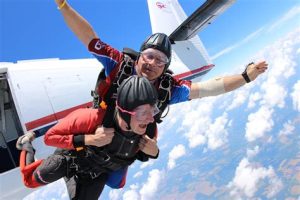Table of Contents
Discover the weight restrictions for tandem skydiving and get ready for an exhilarating adventure. Learn about the maximum weight limit, safety precautions, and equipment requirements. Take the leap and experience the adrenaline rush of freefalling with a certified instructor by your side. Book your tandem skydiving experience today!
Are you ready to experience the ultimate thrill of free falling through the sky? If so, tandem skydiving is the adventure for you! But before you jump out of that plane, there’s an important detail you need to know about: the weight limit. Don’t worry, we’ve got you covered with all the information you need. So, let’s dive in and find out everything there is to know about the tandem skydiving weight limit.
Introduction
Welcome to the world of tandem skydiving! If you’ve ever dreamt of experiencing the exhilarating feeling of freefalling from thousands of feet above ground, tandem skydiving is the perfect adventure for you. However, before you embark on this thrilling journey, it’s essential to understand the tandem skydiving weight limit and its implications.
Why is there a weight limit?
Tandem skydiving involves two individuals jumping together – a trained instructor and a participant. The weight limit is in place to ensure the safety of both individuals involved. The combined weight of the instructor and the participant affects the parachute’s performance, as well as the overall stability and control during the jump.
The typical weight limit
The weight limit for tandem skydiving can vary depending on the drop zone and the equipment used. However, the average weight limit for most skydiving centers is around 220-230 pounds (100-105 kilograms) for men and 200 pounds (90 kilograms) for women. It’s important to note that these limits are not set to discriminate against anyone but rather to prioritize safety.
Factors affecting the weight limit
Several factors contribute to the determination of the tandem skydiving weight limit:
- Equipment: Different parachutes have different weight capacities, and the choice of equipment can impact the overall weight limit.
- Altitude and temperature: Higher altitudes and colder temperatures can affect the parachute’s performance, necessitating a lower weight limit.
- Experience of the instructor: Some experienced instructors may have higher weight limits due to their expertise and ability to handle heavier participants.
Exceeding the weight limit
If you exceed the specified weight limit, it’s crucial to discuss your situation with the skydiving center. In some cases, they may be able to accommodate individuals above the standard weight limit by assessing the specific circumstances and making the necessary adjustments.
Health considerations
While weight is a primary factor in determining the tandem skydiving weight limit, it’s not the sole consideration. Health and fitness also play a crucial role in ensuring a safe and enjoyable jump. Participants should be in good overall health, free from any medical conditions that may pose a risk during the jump.
Booking and disclosure
When booking your tandem skydiving experience, it’s essential to provide accurate information regarding your weight. Disclosing your weight truthfully allows the skydiving center to make the appropriate arrangements and ensure your safety throughout the entire process.
Alternate options
If you find yourself exceeding the weight limit for tandem skydiving, don’t fret! Many drop zones offer alternative experiences such as indoor skydiving or static line jumps, which may have different weight requirements. These alternatives still allow you to experience the thrill of skydiving and enjoy an unforgettable adventure.
Conclusion
Understanding the tandem skydiving weight limit is crucial for both your safety and the overall success of your jump. By adhering to these guidelines, you can ensure that your skydiving experience is not only thrilling but also safe and enjoyable. So, get ready to feel the rush of adrenaline as you embark on this incredible adventure!
Tandem Skydiving Weight Limit
Welcome to our tandem skydiving weight limit guidelines! Before you embark on this exhilarating adventure, it is important to understand the weight restrictions we have in place to ensure your safety and the safety of our instructors.
Determining Your Weight
To determine your eligibility for tandem skydiving, we require you to accurately know and disclose your weight. Step on a scale or visit a nearby gym or clinic to obtain an up-to-date measurement.
Weight Limit Range
Our tandem skydiving weight limit ranges between 200 pounds (90 kg) and 240 pounds (109 kg). Individuals falling within this range will generally be suitable for tandem skydiving but need to meet a few other requirements as well.
Body Composition
In addition to weight, your body composition plays a crucial role in determining whether you can participate in tandem skydiving. It is important to have a healthy weight distribution that allows for secure harness and equipment fastening. If you have any concerns, consult with our experienced instructors beforehand.
Physical Fitness
Being physically fit is vital for tandem skydiving. While we don’t expect you to be an Olympic athlete, a reasonable level of fitness is necessary. Ensure you can comfortably meet the physical demands of the jump, including the ability to maintain a stable body position during freefall.
Safety and Equipment
Keeping safety as our top priority, our tandem equipment is designed specifically for individuals within our weight limit range. Exceeding this limit may jeopardize the equipment’s functioning, potentially compromising your safety and the success of the jump.
Additional Considerations
Please note that height is not a determining factor for tandem skydiving, but it is important to consider how it may affect your weight distribution. Tall individuals may have different weight limits due to variations in body composition.
Enjoy the Experience
Lastly, we hope you have an amazing time tandem skydiving with us! Our weight limit guidelines are in place to guarantee a safe and unforgettable experience for everyone involved. If you have any queries or concerns, our friendly customer service team is always here to assist you.
When it comes to tandem skydiving, weight limits and instructions are of utmost importance. It is crucial that instructors convey these guidelines with a clear and confident voice, while maintaining a friendly and encouraging tone. Here is a point of view regarding the use of instructions voice and tone for tandem skydiving weight limit:
-
Clarity: Instructors should use a clear and concise voice to explain the weight limit requirements. They must clearly state the maximum weight allowed for a safe tandem skydiving experience. This ensures that participants fully understand the importance of adhering to these limits.
-
Confidence: The instructions should be delivered in a confident and reassuring tone. Instructors should emphasize that weight limits are set for safety reasons and that they have been carefully determined to ensure an enjoyable and risk-free skydiving experience. This instills confidence in participants and helps them trust the expertise of their instructor.
-
Friendliness: While maintaining professionalism, instructors should adopt a friendly and approachable tone. They should make participants feel comfortable and at ease throughout the weight limit discussion. This helps create a positive atmosphere and encourages participants to ask questions or seek clarification if needed.
-
Encouragement: Instructors should use an encouraging tone when discussing weight limits. They can highlight the benefits of adhering to these limits, such as increased safety and the ability to fully enjoy the exhilarating experience of tandem skydiving. By motivating participants, instructors can create a sense of excitement and anticipation.
-
Reassurance: It is important for instructors to reassure participants that weight limits are not a judgment on their abilities or physical appearance. Instead, weight limits are solely in place to ensure a safe and enjoyable experience for everyone involved. Instructors should emphasize that they are there to support and guide participants throughout the entire process.
By using a combination of clarity, confidence, friendliness, encouragement, and reassurance, instructors can effectively communicate the importance of tandem skydiving weight limits. This ensures that participants understand and follow these guidelines, ultimately leading to a safe and unforgettable skydiving adventure.
Thank you for taking the time to visit our blog and learn more about the weight limit for tandem skydiving. We understand that this topic is important for many individuals who are considering experiencing the thrill of a tandem skydive. In this closing message, we would like to summarize the key points discussed in the article and provide some final thoughts.
First and foremost, it is crucial to understand that tandem skydiving weight limits are in place for safety reasons. The weight limit is determined by various factors, including the equipment used and the capacity of the aircraft. Exceeding the weight limit can compromise the overall safety of the jump, as it may affect the parachute deployment and landing. Therefore, it is essential to adhere to the weight restrictions set by the skydiving center or operator you choose.
We also discussed the average weight limit for tandem skydiving, which typically ranges from 200 to 240 pounds. However, it is important to note that weight limits can vary depending on individual circumstances, such as height and body composition. Some skydiving centers may have different weight limits or may offer specialized equipment for individuals who are above the average weight range. It is always recommended to contact the skydiving center directly to discuss any concerns or questions regarding weight limits.
In conclusion, tandem skydiving weight limits are in place to ensure the safety and well-being of all participants. It is vital to adhere to these restrictions and communicate with the skydiving center to address any specific concerns or requirements. Remember, skydiving is an incredible experience that can be enjoyed by individuals of various weights and sizes. By following the guidelines set by the professionals, you can embark on an exhilarating adventure while prioritizing your safety above all else.
We hope this article has provided you with valuable information about tandem skydiving weight limits. If you have any further questions or would like to share your own experiences, please feel free to leave a comment below. We appreciate your readership and wish you the best in your future skydiving endeavors!
Video Tandem Skydiving Weight Limit
People also ask about Tandem Skydiving Weight Limit:
-
What is the weight limit for tandem skydiving?
Tandem skydiving weight limits can vary depending on the dropzone and the equipment they use. However, the average weight limit for tandem skydiving is around 220-230 pounds (100-105 kilograms). Some dropzones may have lower or higher weight limits, so it’s advisable to check with the specific dropzone you plan to jump with.
-
What happens if I exceed the weight limit for tandem skydiving?
If you exceed the weight limit for tandem skydiving set by the dropzone, it might not be possible for you to participate in a tandem skydive. The weight limit exists to ensure safety during the jump as it relates to the equipment and the tandem instructor’s ability to control the descent. If you are above the weight limit, the dropzone may offer alternatives such as solo skydiving or postponing the jump until you are within the weight limit.
-
Is there a minimum weight requirement for tandem skydiving?
Yes, there is usually a minimum weight requirement for tandem skydiving, which is typically around 100 pounds (45 kilograms). This requirement ensures that the harness system fits properly and allows for safe deployment of the parachute. It’s important to note that different dropzones might have slightly different minimum weight requirements, so it’s best to check with the specific dropzone you plan to jump with.
-
Can I go tandem skydiving if I’m pregnant?
No, it is generally not recommended to go tandem skydiving if you are pregnant. The activity involves sudden accelerations, decelerations, and potential impacts, which can pose risks to both the mother and the unborn child. It’s crucial to prioritize the safety and well-being of both individuals, so it’s best to postpone skydiving until after the pregnancy.
-
Are there any age restrictions for tandem skydiving?
Most dropzones require participants to be at least 18 years old to go tandem skydiving. This age restriction is in place due to legal reasons and to ensure that individuals have the maturity and understanding necessary to follow instructions and safely enjoy the experience. Some dropzones may also have upper age limits, although they are less common. It’s advisable to check with the specific dropzone regarding their age restrictions before making a reservation.






